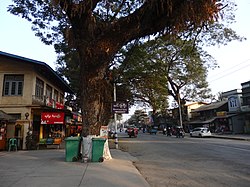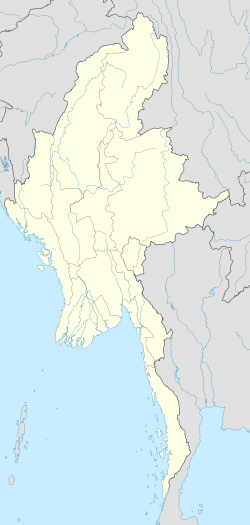
Magway Region is an administrative division in central Myanmar. It is the second largest of Myanmar's seven divisions, with an area of 44,820 km2. Pa Del Dam (ပဒဲဆည်) is one of the dams in Aunglan Township, Magway Division. The capital and second largest city of the Magway Division is Magway. The largest city is Pakokku. The major cities of Magway Division are Magway, Pakokku, Aunglan, Yenangyaung, Taungdwingyi, Chauk, Minbu, Thayet and Gangaw.

Pakokku is the largest city in the Magway Region of Myanmar. It is situated about 30 km northeast of Bagan on the Irrawaddy River. It is the administration seat of Pakokku Township, Pakokku District and Gangaw District. Pakokku Bridge is part of the India–Myanmar–Thailand Trilateral Highway and is the longest bridge in Myanmar. It is home of the Pakokku Airport.
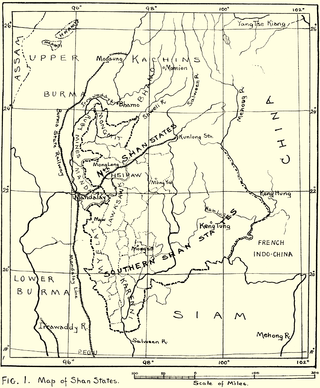
Wuntho or Waing Hso was a native state of Upper Burma when Burma (Myanmar), was under British control. It had an area of around 6,200 square kilometres (2,400 sq mi) with 150,000 inhabitants and lay midway between the Ayeyarwady River and Chindwin Rivers.

Laihka State, also spelt Legya or Lecha, was a state in the central division of the Southern Shan States of Burma, with an area of 3,711 square kilometres (1,433 sq mi).
Gangaw is a town of Gangaw Township in Gangaw District in the Magway Division in Myanmar. Gangaw is also known as the City of Yaw, a certain region in Myanmar including Gangaw (ဂန့်ဂေါ), Tilin (ထီးလင်း), Saw (ဆော) and villages around them. Gangaw District and Gangaw township was a part of Pakokku District until 2003.In 2003,Gangaw District was established. Myit Thar river (မြစ်သာမြစ်) flows from South to North dividing the town into Gangaw and Western Gangaw (အနောက်ဂန့်ဂေါ) village.

Yawnghwe, known as Nyaungshwe in Burmese, was a Shan state in what is today Myanmar. It was one of the most important of the Southern Shan States. Yawnghwe state included the Inle Lake. The administrative capital was Taunggyi, located in the northern part of the state. The Agent of the British government, the Superintendent of the Southern Shan States, resided at Taunggyi and the king's palace was at Yawnghwe.
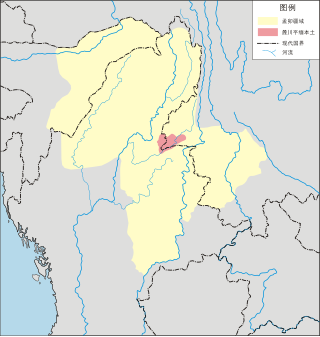
Muang Mao, also spelled MöngMao or the Mao Kingdom, was an ethnic Dai state that controlled several smaller Tai states or chieftainships along the frontier of what is now Myanmar, China, the states of Northeast India of Assam, Nagaland, Manipur and Arunachal Pradesh principally set in the Dehong region of Yunnan with a capital near the modern-day border town of Ruili/Meng Mao. The name of the main river in this region is the Nam Mao, also known as the Shweli River.

Longchuan County is a county located in Dehong Prefecture, Yunnan province, southwestern China.

Mandalay Central railway station, located in downtown Mandalay, is one of the largest rail stations in Myanmar. The station is Upper Myanmar's gateway to the 3,126-mile (5,031 km) national rail network. It is the terminus of the main rail line from Yangon and the starting point of branch lines to Pyin U Lwin (Maymyo), Lashio, Monywa, Pakokku, Kalay, Gangaw, and to the north, Shwebo, Kawlin, Naba, Kanbalu, Mohnyin, Hopin, Mogaung and Myitkyina.
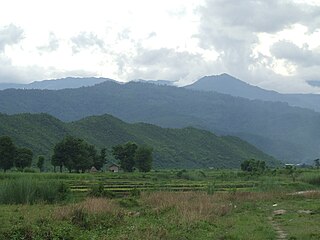
Kale District is the westernmost district in Sagaing Division of Myanmar (Burma).

Hsipaw, also known as Thibaw, is the principal town of Hsipaw Township in Shan State, Myanmar on the banks of the Duthawadi River. It is 200 kilometres (120 mi) north-east of Mandalay.

Mongmit or Möngmit, also known as Momeik, was a Shan state in the Northern Shan States in what is today Burma. The capital was Mongmit town. The state included the townships of Mongmit and Kodaung.

Lawksawk, also known as Yatsawk was a Shan state in what is today Burma. It was located north of Myelat and belonged to the Central Division of the Southern Shan States. Its capital was Lawksawk town. The state included 397 villages and the population was mostly Shan, but there were also Danu, Pa-O and Palaung people in the area.

Mongpai, also known as Mobye, was a Shan state in what is today Burma. It belonged to the Central Division of the Southern Shan States. Mongpai was based in the modern town of Mobye.

The Kingdom of Pong or Pong Kingdom was an ethnically Tai state that controlled several smaller states along the frontier of what is now Myanmar, China and Northeast Indian states of Assam, Manipur, Nagaland and Arunachal Pradesh.
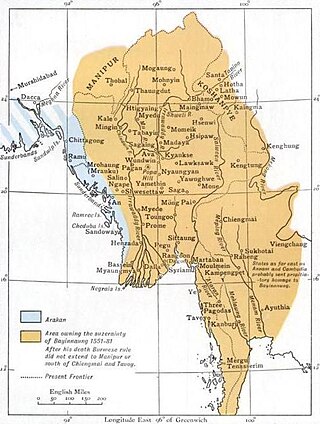
Hsawnghsup was one of the outlying Shan princely states in what is today Burma.

Mogaung or Möngkawng was a Shan state in what is present-day Myanmar. It was an outlying territory, located away from the main Shan State area in present-day Kachin State. The state existed until 1796. The main town was Mogaung.

Wanmaw, Manmaw or Banmaw (Bhamo) was a Shan state in what is today Burma. It was an outlying territory, located away from the main Shan State area in present-day Kachin State close to the border with China.

Pakokku–Kalay Railway is a railway line operated by Myanma Railways under the Ministry of Transport and Communications. This railway connects towns on the western bank of the Ayeyarwady River, such as Pakokku, Myaing, Gangaw, and Kalay. The railway spans a total of 240.47 miles in distance, with a track length of 274.04 miles and includes 65 stations.
